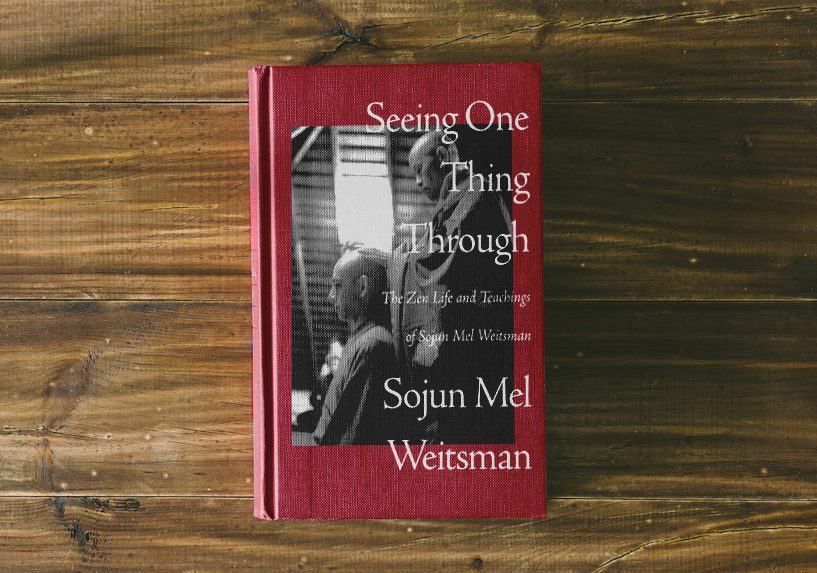Seeing One Thing Through: The Zen Life and Teachings of Sojun Mel Weitsman.
Book Review
This worthwhile collection of Dharma talks also includes a fascinating look at the turbulent history of Zen in America.
 ©
© COUNTERPOINTS Press, Shutterstock
Mel Weitsman was the disciple of Shunryu Suzuki Roshi (1904-1971), who founded the Tassajara Zen Mountain Center in northern California, the first Zen Buddhist monastery outside Asia. Suzuki wrote Zen Mind, Beginners Mind which remains one of the most popular introductions to Zen Buddhism in the West. In 1967, after Weitsman helped him build Tassajara, Suzuki asked him to start a Zen Center in Berkeley and two years later installed him as its abbot. When Weitsman enquired, “What is nirvana?” Suzuki replied, “Seeing one thing through to the end.” And this is precisely what the young abbot did. As Sojun (White Dragon) Mel Weitsman, he directed the Berkeley Zen Center for the next 53 years. He also taught at other Zen centers in and around San Francisco until his death in 2021 at the age of 91.
Seeing One Thing Through is partly an autobiography and partly a selection of Sujun Weitsman’s dharma talks over the years. The section entitled “Memories” makes up less than a third of the book. It deals briefly with the author’s early life. A working-class Jewish boy from California, he comes of age during the depression. Hitler is coming to power in Germany and anti-Semitism is in the air. In grammar school, a gang of Christian boys surrounds him menacingly: “Hey kid, you Jewish? Don’t you know that the Jews killed Christ?” For a moment he imagines being killed in retaliation. Feeling himself an outsider, he identifies increasingly with blacks and other marginalized groups. His best friend is a precocious artist with a cleft lip. Art is their bond and Weitsman, following a stint in the Marines, goes to art school to study with several well-known painters including the abstract impressionist master, Clifford Still, whom he believes was in some way his first Zen teacher.
Weitsman imbibes the Bohemian culture in California during the 1950s and 1960s: the jazz of Charlie Parker and Miles Davis, the beginning of the sexual revolution, the Beat poets Gary Snyder and Allen Ginsburg, beatniks, pot and LSD. Inspired by the Jewish mysticism of Martin
Buber, he recognizes a religious temperament in himself and likes the concept of the hidden tsadik or holy man, who appears as an ordinary man or a fool but in reality is a great sage. He also feels an affinity for Jesus Christ, although he can’t reconcile the Jesus story with the Christian religion. He reads some of D.T. Suzuki’s books on Zen. Yet he doesn’t get a sense of meditation practice until he’s introduced to Shunryu Suzuki, with whom he finds an immediate affinity. Suzuki, a Soto Zen priest, has recently arrived from Japan to look after the Japanese congregation in San Francisco, but is open to teaching Westerners and Weitzman soon discovers that his true role in life is to help him in this mission.
Sujun Weitsman appears to be an authentic teacher of Buddhist wisdom and a testament to the transformative power of sincere Zen practice. I must confess, however, that I had a few initial reservations. In Buddhist circles, at least in the UK, American Zen lost its lustre long ago. Many of the early teachers who came to America following World War II did so without completing their formal training. They set themselves up as Zen Masters, became embroiled in sex scandals and were accused of abusing their positions as teachers. My own teacher Myokyo Zenji referred to it as a horror show. Recently Jeff Shore, an American-born Zen teacher, who teaches at Hanazono University in Tokyo, called out the Zen establishment in Japan for failing to raise the issue and thereby harming the reputation of Zen in America. Weitsman’s teacher, Shunryu Suzuki, wasn’t involved in any scandals, but died young, appointing Richard Baker as his official successor. Baker proved to be an unfortunate choice, as Weitsman clearly explains in his book. Yet somehow the San Francisco Zen Centre survived, and Sojun Weitsman’s own practice blossomed and matured as did his extensive teaching career.
If you want to learn what happened when Zen came to America, this book is an excellent place to start. There are also many nuggets of wisdom in Weitsman’s biography. The following quote seems particularly apt:
“Samadhi is like playing in the waves without getting pulled under. If you can do that, your life can be happy even though you have many problems. This is the joyful path that cannot be extinguished by circumstances.”




